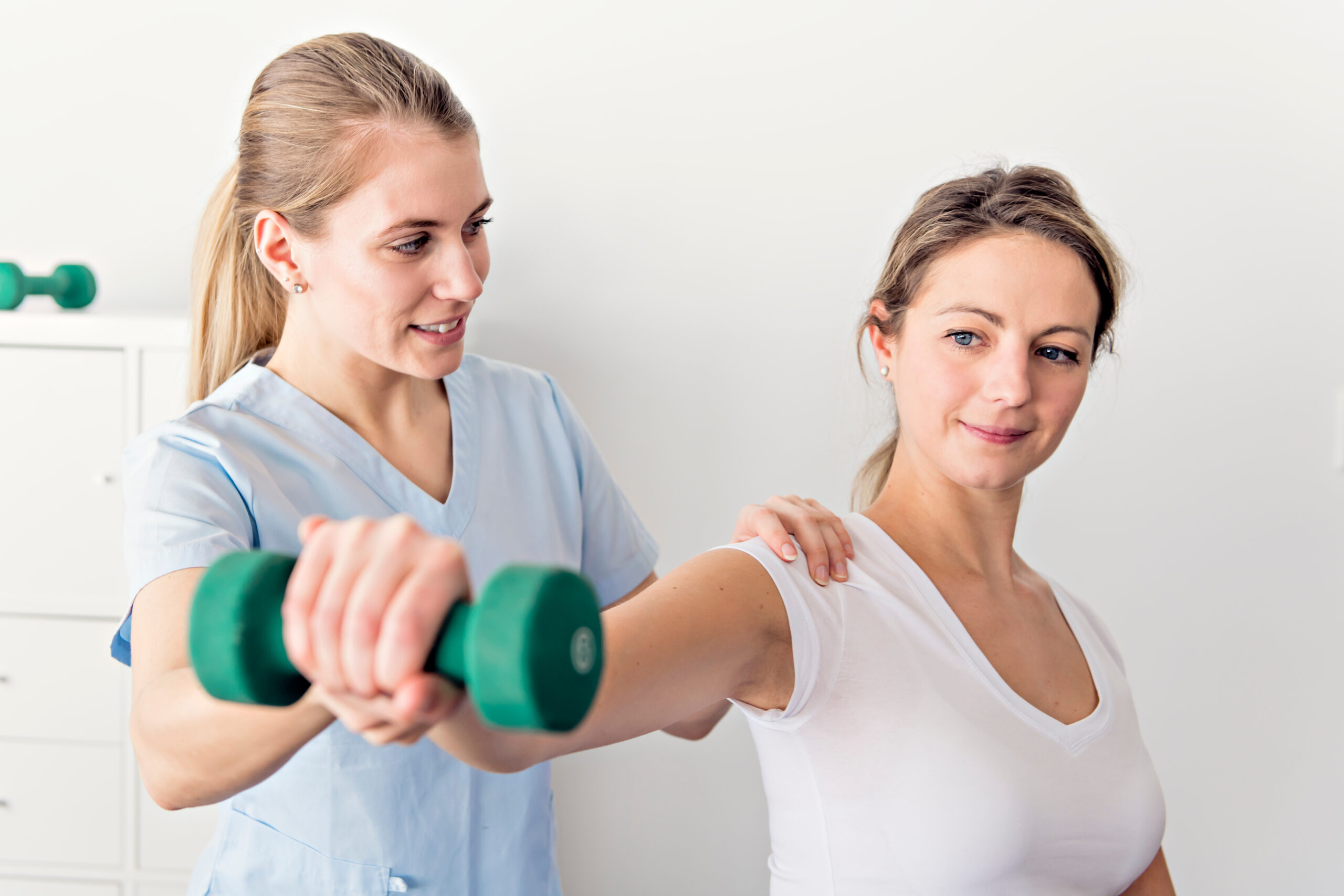An estimated 1 of every 4 rotator cuff repairs will re-tear within 6 months of surgery. Overly aggressive rehabilitation or inappropriate use of the arm can increase your risk. A few months after surgery, most people begin to feel pretty good. And this is the time when you will be tempted to progress too quickly and do too much. Don’t take the chance. If you want to achieve the best outcome from rotator cuff surgery, perform your rehabilitation under the guidance of your physical therapist.
Rotator cuff tendon healing is considered sufficient to begin gentle strengthening exercises between the 12th and 16th week after surgery. After restoring your range of motion, resistance must be gradually introduced and progressed. The purpose of this article is to highlight several key exercises used during the later phases of rehabilitation after rotator cuff surgery. Your physical therapist will help you develop the best individualized plan based on your surgery and long-term goals.
Strengthening Exercise after Rotator Cuff Surgery
Strengthening exercises for your rotator cuff are initiated below–chest level with exercises such as internal and external rotation. During active-assisted arm elevation exercises, you must maintain appropriate form to minimize the risk of developing compensations.
A common compensation is to “shrug” your entire shoulder when attempting to raise your arm overhead. When you can perform a press-up exercise overhead without compensation, you are ready to progress to performing the full-can scaption with a light dumbbell. The level of resistance is generally kept low (1 to 2 pounds) but may be increased based on your functional demands.
External Rotation in Side-Lying
This exercise is ideal for strengthening 2 of your rotator cuff muscles, the infraspinatus, and teres minor. Begin lying on your side with your involved arm on top. Keep your elbow bent at 90 degrees throughout the exercise. Rotate your arm upwards through a full range of motion while keeping your elbow tucked to the side of your body. Hold the top position for 2 to 3 seconds before slowly lowering back to the starting position. Do 2 to 3 sets of 10 to 20 repetitions.
Band Internal Rotation @ 0 Degrees
This exercise is ideal for strengthening your subscapularis muscle of the rotator cuff. Begin standing with your involved arm closest to where the resistance band is anchored. Keep your elbow bent at 90 degrees throughout the exercise. Rotate your arm inwards through a full range of motion while keeping your elbow tucked to the side of your body. Hold the this position for 2 to 3 seconds before slowly returning to the starting position. Do 2 to 3 sets of 10 to 20 repetitions.
Wand-Assisted Flexion in Standing
This exercise helps transition back to full overhead reaching activities. Stand holding a wand or cane in both hands. Your uninvolved arm will assist in elevating your involved arm overhead. Keep your elbow straight with a thumb-up position throughout the exercise. The thumb-up position increases rotator activation and minimizes the risk of shoulder impingement when the arm is raised. It is important to slowly control the lowering of your arm using as much of your involved side as possible. Hold the top position for 2 to 3 seconds. Do 2 to 3 sets of 10 repetitions.
Serratus Punch
This exercise activates your rotator cuff and shoulder blade muscles. It incorporates a more functional reaching movement. Begin with a resistance band anchored behind you. Start with your hand close to the body and your elbow bent. Perform a punching movement with a slight upward inclination. Hold the top position for 2 to 3 seconds before slowly returning to the starting position. Do 2 to 3 sets of 10 to 20 repetitions.
Press-Up in Standing
This exercise is a progression of wand-assisted flexion in standing. Initially, the exercise is performed without any weight. As the strength of your rotator cuff improves, add 1 to 2 pounds.
In a standing position, start with your hand close to your body and your elbow bent. A pressing movement is performed overhead. Straighten your elbow as your arm passes overhead. Hold the top position for 2 to 3 seconds before slowly lowering your arm back down to the starting position. Do 2 to 3 sets of 10 repetitions. Be sure to avoid “shrugging” your shoulder or arching your lower back.
Full-Can Scaption
After you can properly do the press-up exercise, add the full-can scaption to improve your rotator cuff strength. This exercise specifically targets your supraspinatus muscle which is the most commonly torn tendon of the rotator cuff.
Start from a standing position with your elbow straight and thumbs pointing up. Elevate your arms from an angle midway between the front and side of the body. Hold the top position for 2 to 3 seconds before slowly lowering your arm back down to the starting position. Do 2 to 3 sets of 10 repetitions. Be sure to avoid “shrugging” your shoulder or arching your lower back.
See Your Physical Therapist for the Best Results
Rehabilitation after rotator cuff surgery is a slow progression lasting anywhere from 3 to 6 months. Your physical therapist will be your guide through the process. You will safely progress most effectively based on your healing capabilities and long-term goals. Your physical therapist will know when to ramp things up and when to slow things down. In the end, you will feel like a new person.
To get started with your rehabilitation, contact your physical therapist .


